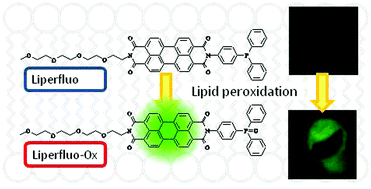A novel fluorescent probe with high sensitivity and selective detection of lipid hydroperoxides in cells
Abstract
Spy-LHP was developed as a

* Corresponding authors
a
Systems Life Sciences, Department of Medical Life Systems, Faculty of Medical and Life Sciences, Doshisha University, Kyotanabe 610-0394, Japan
E-mail:
nnoguchi@mail.doshisha.ac.jp
Fax: +81-774-65-6262
b Dojindo Laboratories, Kumamoto, Japan
Spy-LHP was developed as a

 Please wait while we load your content...
Something went wrong. Try again?
Please wait while we load your content...
Something went wrong. Try again?
K. Yamanaka, Y. Saito, J. Sakiyama, Y. Ohuchi, F. Oseto and N. Noguchi, RSC Adv., 2012, 2, 7894 DOI: 10.1039/C2RA20816D
To request permission to reproduce material from this article, please go to the Copyright Clearance Center request page.
If you are an author contributing to an RSC publication, you do not need to request permission provided correct acknowledgement is given.
If you are the author of this article, you do not need to request permission to reproduce figures and diagrams provided correct acknowledgement is given. If you want to reproduce the whole article in a third-party publication (excluding your thesis/dissertation for which permission is not required) please go to the Copyright Clearance Center request page.
Read more about how to correctly acknowledge RSC content.
 Fetching data from CrossRef.
Fetching data from CrossRef.
This may take some time to load.
Loading related content
